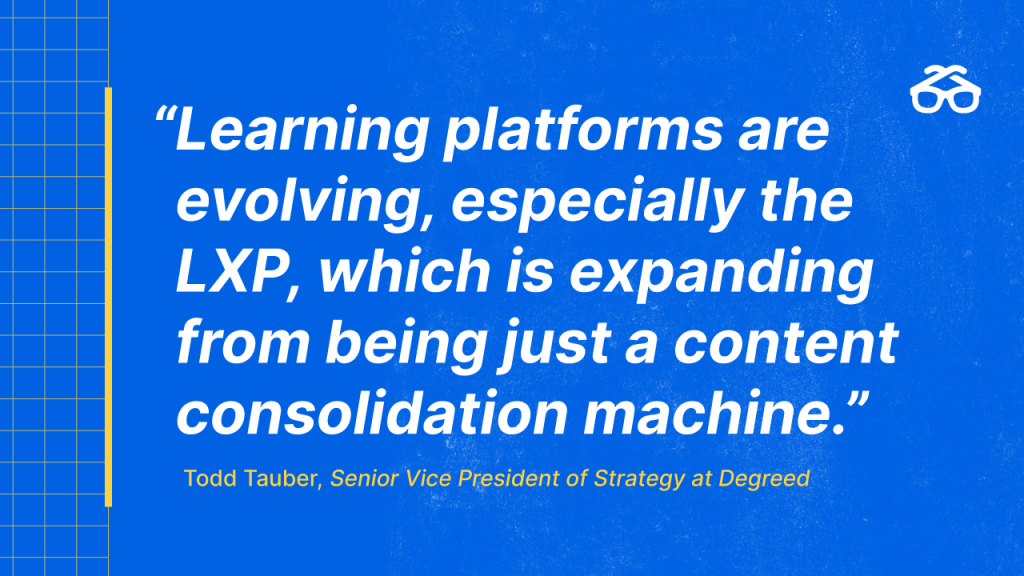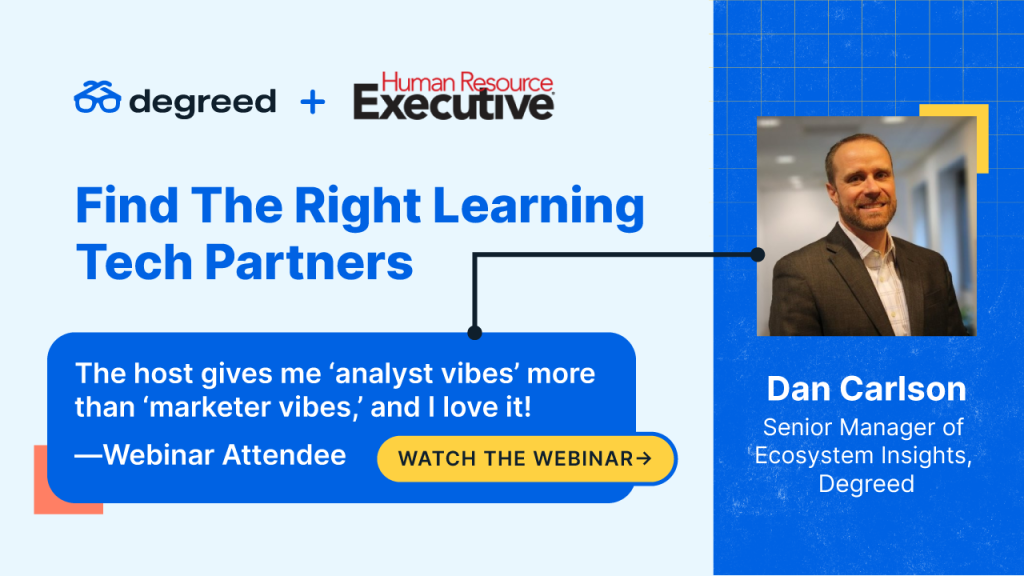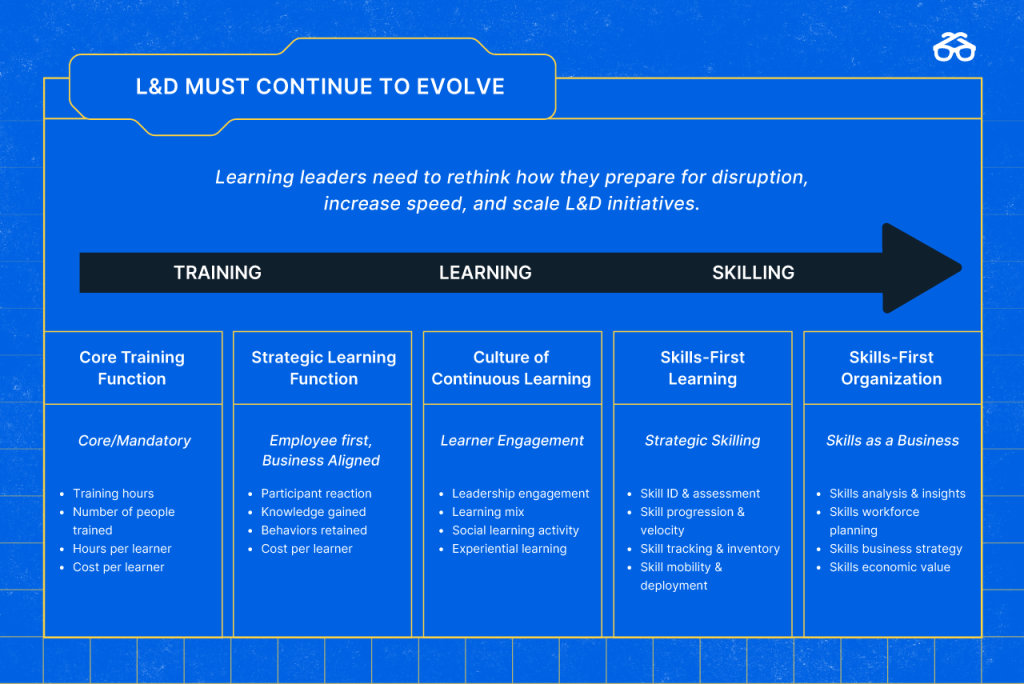A lot happens in a decade—especially in tech. This proved particularly true with the learning experience platform (LXP). The LXP is now more than 10 years old, and a “How to choose a learning experience platform” article from five years ago would differ significantly from a how-to article today.
In other words, it’s time for a “How to Choose an LXP” refresh. While the learning experience platform may have started as a content consolidation machine, today it’s a lynchpin in learning ecosystems and a lever to pull for business results.
With these evolutions in mind, here is your refreshed guide on how to choose a learning experience platform in 2024.

Critical Product and Value Shifts
Using an LXP, employees can learn, grow, and expand their capabilities beyond what was listed on their resumes the day your organization hired them. For this reason, the learning experience platform is an incredible storehouse of critical learning and skill data, and that information needs to be shared.
L&D needs better data for strategy, talent, and recruitment, so naturally, as a product, the LXP has become a master at connecting with other platforms. “The LXP is something that connects workforce intelligence and talent to internal marketplaces, HCM systems, and people analytics,” explains Todd Tauber, Senior Vice President of Strategy at Degreed.
Not only has the learning experience platform become a lynchpin of the learning ecosystem, but L&D objectives have changed—especially in the past few years. In the beginning, the buzzwords that got C-suite executives, well, buzzing, were “engagement” and “learning culture.” While those are still in the lexicon, today it’s all about getting stuff done and impacting the business.
Amid recent economic hardships and tightening budgets, the focus for the learning experience platform today is business impact. So as we look forward, let’s think more about framing the value of the LXP as a powerful tool to advance the business and less about bells, whistles, features, and functions.
The Nuances of Choosing a Learning Experience Platform
Thinking of the LXP as a lynchpin and focusing on business results alters yesteryear’s strategies for choosing an LXP. While many bullet points from how-to guides are the same as they were ten years ago, it’s nuance that matters today. A great way to illustrate the importance of nuance is with the number one bullet point on most “How to choose a software” articles—cost.
Cost: Look beyond the price tag.
When you’re exploring different solutions, it’s easy to ask vendors for a budget that includes implementation fees. It’s easy to review a per-user license fee and to compare apples to apples. That was mostly how you’d look at costs when comparing LXPs in years past, but today it’s not as simple.
Remember how the C-suite is all about business impact? There’s a reason we commissioned our Degreed Total Economic Impact study with Forrester Consulting—to get to the bottom of cost versus value. The data speaks for itself. With Degreed, you have the flexibility to reap big benefits like more efficient onboarding, better retention in key roles, improved employee upskilling, learning content savings, and an overall return on investment of 312%.
This isn’t to pat ourselves on the back. Well, perhaps just a little. More importantly, it’s to illustrate the kinds of stats you’ll need to dig up and consider in addition to a dollar sign comparison of price tags. Don’t just figure out the hidden costs here and there. Gather statistics on how much money a solution saved another company and other solid data points that prove overall ROI.
Features and functions: Compare more than long lists.
We’ve said it once, and we’ll say it a million times. If it seems like every vendor out there pretty much does the same thing, that’s intentional. Imitation is the sincerest form of flattery, and when competitors in the L&D space see something that’s working, they jump on the bandwagon.
Most LXPs have strikingly similar functionality although one may do something slightly differently or even better than another. This is why weighing your RFx criteria is key. If three vendors say they support “in the flow of work” learning but only one offers truly robust skill ratings, which of those two things is more important to you and your business?
As we mentioned earlier, today it’s more about framing the value of the LXP as a powerful tool to advance the business and less about bells, whistles, features, and functions. So don’t fall into the pitfall of thinking a list comparing features and functions will help you choose the best learning experience platform.
Instead, focus on researching and discovering how well those features and functions work. Does a feature of one LXP provide better results than the same feature of another? Focus on the things that matter, and hierarchize the rest.
Customer experience: Use more than sales process interactions.
Before signing with a vendor, your company should always consider the experience it’s getting as a customer. But don’t equate customer service with your pre-contract, sales process interactions. It’s all smiles and emails until the contracts get signed, and using those presale niceties as the sole metric for future customer service may not be accurate.
This isn’t to say that you should disregard your early pre-contract experiences with a vendor. It’s important to feel like a vendor gets your company and works well with you. Just be sure to combine those feelings with harder data.

Here’s a tip: Ask vendors if you can speak with some of their current customers before signing a contract. This tip is from Dan Carlson, Senior Manager of Ecosystem Insights at Degreed. Too often you can feel ghosted, gaslit, and abandoned after the ink dries on a contract. To avoid that, have a frank conversation with current customers so you have more realistic customer service expectations.
Here’s yet another tip: Ask and evaluate how well a vendor stays on the cutting edge of technology. A company committed to innovation will continue to grow, learn, and evolve with you. This piece of advice comes from a Degreed collaboration with RedThread Research. Although the advice is more than five years old, it remains a shrewd way to help you assess the vendor’s commitment to you and your future goals.
Flexibility: Prioritize more than one kind of learning.
We’re not talking about adding your brand colors to a home page, we’re talking about using a tool to support your idea of what a learning strategy looks like. When the LXP emerged, many companies focused on one or two learning needs. Now, L&D is evolving and many companies require personalized learning to meet complex and critical learning needs.
Specifically, you can break down a learning strategy into three critical learning needs: training, everyday learning, and skill development. Will a learning experience platform give you the flexibility to support this diversity of learning needs now and into the future?

Degreed, for example, can be used for numerous (and dramatically different) use cases like onboarding, operating, engaging, upskilling, and reskilling. Degreed also covers a range of learning experiences from core training to everyday learning and targeted skill building. If that sounds like a lot, that’s okay. We’ll work with you and your teams to help you decide where to start and where to focus, so the platform works for what you need right now.
Integrations and ecosystem: Plan for many vendors.
As L&D embraces more personalized and complex learning strategies, the tech ecosystem supporting workforce development increasingly becomes more complex. It may seem tempting to source all your solutions from the same vendor or group because that way they all work together and are built (hopefully) to interact. But what happens when that provider doesn’t offer a module that you need? Or when you need to integrate with an outside vendor?
This is exactly why savvy learning leaders choose a vendor with an open ecosystem. Your tech ecosystem will only get more complex, and it is increasingly critical that everyone can play nicely together. This means choosing a vendor that freely supports and encourages integrations with other technologies, services, and platforms. It’s the opposite of a closed ecosystem, in which only one vendor’s own products play nicely together. Expect your L&D strategy to change over time. A welcoming approach to integrations ensures that the technology you buy today will grow with you, not hinder or limit your growth.
The right LXP: The next step is yours.
A learning experience platform is just as critical as it was ten years ago, if not more so. But the criteria for picking an LXP continue to evolve and grow. So when you’re selecting the right LXP for your company in 2024, remain mindful that it now serves as a lynchpin for learning ecosystems and a lever for business outcomes.
Now that you have a better idea of what to look for, get out there and do more research! Scour websites, schedule vendor demos, and speak to executives at companies in your industry to find out who they’re using, and why. If you’re ready to get started with the bid process, check out our article outlining three steps for getting the learning tech bid process right.
Visit our website to find out more about our Degreed, or schedule a demo today.
